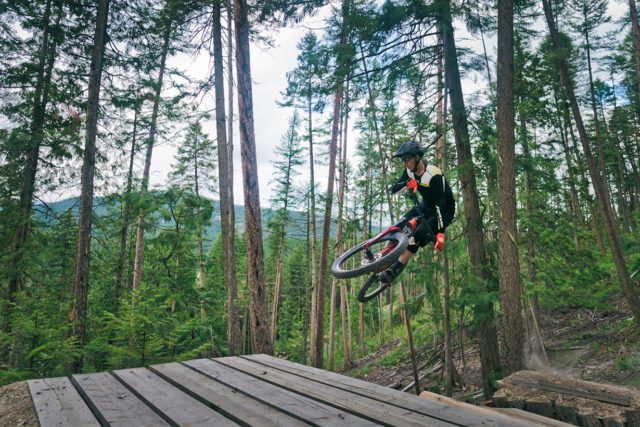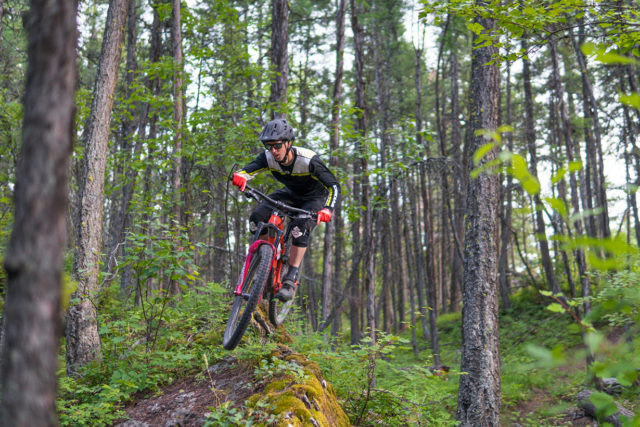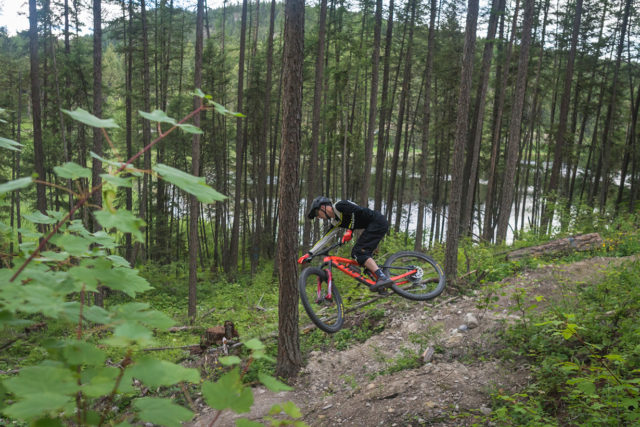
2019 Rockshox Lyrik RC2
MSRP: $999
Travel: 150—180 mm (10 mm increments)
Version Tested: 160 mm RC2, 29” wheels, 51 mm offset
Stanchions: 35 mm
Mounted to: Trek Slash
Blister’s Measured Weight: 2099 g (uncut steerer)
Reviewer: 5’9”, 155 lbs
Test Locations: Montana, British Columbia, and a bunch of other spots
Duration of Test: ~4 months
Intro
The Lyrik isn’t a new fork in the Rockshox lineup, but it underwent some revisions for 2019. I’ve put quite a few miles on the new RC2 version of the fork, which has the Lyrik’s most adjustable damper, Rockshox’s DebonAir spring, and, most importantly, it comes in “BoXXer Red,” which is obviously the fastest color in the Lyrik lineup.
I was mostly a fan of the prior iteration of the Lyrik — it was supple and smooth, and the chassis was plenty stiff to keep everything tracking straight. So are the new changes noticeable? And are they actually better?
Options and New Tech
The Lyrik is still offered in a few different variations: there’s the RC (which has the Charger 2 damper, DebonAir spring, rebound and low-speed compression adjustments), the RCT3 (Charger 2 damper, DebonAir spring, rebound and low-speed compression adjustments, plus a three-position open/trail/firm adjustment), and there’s also a version of the RCT3 with a dual-position air spring (travel can be reduced to lower the front end for climbing).
And then there’s the RC2 that I rode, which has a DebonAir spring and a Charger 2 damper with externally adjustable rebound, low-, and high-speed compression. On the RC2’s compression damper, you get 19 clicks of low-speed adjustment, and 4 clicks of high-speed compression adjustment. While both Rockshox and Fox had been trending toward less adjustments on most of their Trail forks, the RC2 is a return to more adjustability in lieu of quick and easy pre-set damping adjustments. Of the Lyriks, the RC2 is the most adjustable version, and it’s the one that you’ll see most of the Rockshox-sponsored Enduro racers riding.
Among the various options, the RC is probably your best bet if you’re on a bit of a budget (although the Yari shares the Lyrik’s chassis, and comes in quite a bit less expensive). The RCT3 would be the way to go if you find yourself using the “trail” or “firm” modes on smoother trails and climbs, and the dual-position RCT3 would be ideal for anyone who hates wheel flop and a wandery front end on steep climbs. But for those who really want to dial in their front suspension, the RC2 gives you the most control over how your suspension feels.

All of the Lyriks run on essentially the same chassis — 35 mm stanchions, and lowers that provide clearance for tires up to 2.8”. Travel options are available in 10 mm increments from 150 mm up to 180 mm for both 27.5” and 29” wheels. And for each wheel size, there are two available offsets — 51 mm and 46 mm for the 29er, and 42 mm and 37 mm for the 27.5”.
Throughout the Lyrik lineup, the fork accepts post mount brakes with a 180 mm rotor without an adapter, and will fit up to a 203 mm rotor. Axles are available in either Maxle Stealth (which requires a wrench to remove), or Maxle Ultimate, which can be removed without tools.
The DebonAir spring originated on Rockshox’s rear shocks, but has spread throughout their fork lineup. The general idea behind the DebonAir spring is to increase air volume, particularly in the negative air chamber. The larger negative air chamber helps to overcome the seal stiction that’s inherent to any air fork, which makes a big difference in compliance at the beginning of the fork’s travel. In other words, small-bump sensitivity is significantly improved.
The other change comes in the form of the Charger 2 damper, which sees revisions to the low-speed compression adjustments to provide a wider range and to make the adjustment more usable for a broader variety of riders.
On the Trail
I rode the Lyrik RC2 in a 29” wheeled, 160 mm travel, 51 mm offset configuration, which was the same as the Fox 36 Performance that came on my Trek Slash. For the initial setup, I opened both the low- and high-speed compression adjustments all the way, and I set air pressure according to the chart Rockshox puts on the fork leg. For my weight, this meant right around 70 psi. The fork came with two volume-reducing tokens installed, which I left in for the time being.
Initial impression on my first ride: holy crap, this thing is ridiculously smooth. I would have said that older Lyriks were quite good in terms of small-bump sensitivity — they were some of the better options on the market in terms of suppleness at the beginning of the stroke. But the new Lyrik, presumably due to the addition of the DebonAir spring, takes it to a whole different level.
Once I mounted this fork, a pretty frequent event started happening at trailheads. A random rider would see my bike, and something along the lines of the following conversation would follow:
Random Rider: “Oooh, you have a red Lyrik. Are you sponsored?”
Me: “No, they’re available to mortals now.”
Random Rider: “Can I push on it?”
(They push on it)
Random Guy: “Niiiiiice.”
Now, pushing on a fork a little bit in a parking lot is a spectacularly shitty way to assess how good the fork is. But my point is that the smoothness and the lack of stiction at the beginning of the Lyrik RC2’s stroke is immediately noticeable, and according to a bunch of random guys in parking lots around the country, I’m correct about this.

So what does that mean on the trail? It means the fork tracks spectacularly well through bumpy corners, and it maintains traction on the front wheel better than any single-crown fork I’ve ridden. And it’s arguably better than some of the DH forks I’ve ridden, despite having 40 mm less travel. I’ve actually noticed that, after mounting the Lyrik RC2, I’ve changed my riding position a bit and I’ve begun riding more forward on the bike, in large part because the fork keeps the front wheel glued to the ground and I’m more comfortable committing to corners over the front of the bike.
And the Lyrik RC2’s performance isn’t just limited to small-bump awesomeness — it’s entirely composed on medium and large hits as well. Running two tokens in the fork and Rockshox’s recommended air pressure means it takes some effort to hit the bottom of its travel. But if I’m riding in a bike park or a place where big hits are more frequent, a click or two of high-speed compression keeps me from bottoming out harshly.
And throughout my time on the Lyrik RC2, I never found that performance deteriorated or changed significantly, even on long 3000+ foot descents. The same goes for temperature variances — I’ve found some forks feel fairly crappy when they get cold, but I’ve had a few days on the Lyrik where temps were hovering around freezing and there was snow on the ground, but it still felt nice and smooth.
An issue some people had with the older Lyriks was that they tended to ride a bit lower in their travel. I wouldn’t say they wallowed in the mid-stroke, or anything that severe, but particularly compared to the higher-end Fox 36’s, the Lyriks tended to get into the middle of their travel a bit more easily.
The new Lyrik seems to ride a bit higher than the old Lyriks, but maybe not quite as high as the 36’s. But that assessment is pretty vague because it really depends on how the fork is set up. Personally, I preferred the Lyrik RC2 with slightly lower air pressures, 2 volume-reducing tokens, zero or one click of high-speed compression (from open), and I’d adjust low-speed compression based on where I was riding, but usually hovered around a quarter to halfway through the adjustment range, from fully open. That setup yielded fantastic small-bump compliance and traction as well as big ramp-up at the end of the stroke to deal with super hard hits, but it probably rode a little lower in the travel than if I’d removed one (or both) of the tokens and ran slightly higher pressures with more damping.

Long story short: there are a lot of adjustment opportunities with the DebonAir spring and the RC2 damper. As a broad generalization, I’d say the 36’s ride a bit higher in their travel, but I’d also say that the 36’s don’t do nearly as good a job of ironing out small bumps and providing supple traction through the first third of the fork’s travel. But I say that with the significant caveat that I haven’t spent much time on Fox’s new Grip2 damper, which by most accounts is a big improvement over prior 36’s in terms of small-bump compliance.
In terms of the fork’s chassis, the Lyrik feels pretty stiff to me, but I’m not a huge guy that tends to get a lot of flex out of my forks. Swapping back and forth between the Lyrik and a Fox 36, I’d say they feel roughly comparable in terms of stiffness. I’m sure a machine in a lab could quantify a difference, but I’m not sure it’s significant enough to be a factor in any decision-making process.
Durability and Maintenance
I have nothing much to report here, other than that I’ve done nothing to the Lyrik RC2. I probably have around 1000 miles on the fork, almost all of which have been on fairly rough trails, and the fork still feels great. I’m definitely past Rockshox’s recommended 50-hour service interval for a lower-leg service, and I’m probably approaching the 200-hour service interval for a damper and spring service. So the fact that I’ve done nothing and the fork still feels good seems to at least be an indication that there aren’t any glaring issues with the damper or air spring assembly. That said: don’t be like me. Your fork will last longer if you actually service it more often than never.
The only thing I’d note is that the nice red paint seems to wear off relatively easy, and there’s a bright white undercoat that looks significantly less fast.
Bottom Line
Each passing year, suspension gets a little better. Every company is revising their seals, tweaking their bushings, and coming up with little ways to improve stiffness, decrease weight, and maximize performance. I’ve ridden a lot of forks, and each time I get on the new and improved version, I’ve almost always concluded that, yup, the new version is a bit better than the old one. Which is great: forward progress, and all that.
But I’ll also say that, while those improvements are, in fact, better, they also tend to be somewhat subtle. There are plenty of forks where the model-year improvements are sufficiently minor that most people probably wouldn’t notice a huge difference.
Without trying to get into internet review hyperbole, I will say that the improvements to the new Lyrik are noticeable. It’s not just that the RC2 is more adjustable, it’s that it feels really damn good in pretty much every situation I’ve thrown at it, and it’s a noticeable improvement over the 2018 Lyrik that I spent a fair amount of time on. And more to the point, it doesn’t take a world-cup-level racer to unlock the benefits of the Lyrik — this isn’t a fork that requires a professional suspension engineer to dial in, and going through a pretty straightforward setup procedure will yield impressive control over the front end of the bike. Long story short? I’m super impressed.
And did I mention that it’s red?

I have switched from a fox 36 factory fit4 2016 to a 2019 lyrik with the debon air airspring and I’m really happy about the change. The small bump complience and overall damping was allways too tough for me to really enjoy riding in the park the whole day. Now I’m allwasy astounded that the lifts will close soon because my arms are still feeling fresh! The lyrik really is super smooth.
“Everyone knows red ones are faster”
I’m about to buy a new bike, and was almost exclusively looking at bikes that come with Fox suspension, but now I’m starting to reconsider that thought process.
Thanks Noah!
Just finished a back to back comparison of the new Lyric Rc2 to Fox 36 grip2 on a Commencal Meta 29er at Whistler bike park. One bike with the lyric other with the fox. Swapping bikes back and forth on the trail. Also back to back Lyric rc2 vs rc. The lyric rc2 is quite noticeably better performing than either of the other forks by quite a margin. So supple and responsive.
I used to be a fox fan but no more…